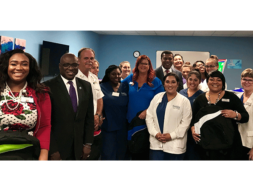
Online Delivery: Silver Bullet or Potential Trap? And What Questions any Institution of Higher Education Should be Asking
By Wallace K Pond, Ph.D.
To do online or not?
Looking back to the mid-1990s, it is fair to say that the quality and sophistication of learning management systems are much improved from the early days of online education. In some ways, it is much easier to be in the “online business” today than it used to be. To be clear, however, the underlying architecture and the pedagogical models are mostly the same as they were 20 years ago.
LMSs do not yet effectively leverage what other applications typically do such as captivating social interaction, user-friendly transactional tools, gaming principles, or even high end adaptive learning capabilities.
What LMSs are good at is providing stable frameworks for holding and disseminating content, basic interactions, highly consistent pedagogical models (far superior to traditional classrooms), and flexibility for learners. Even though online education has a long way to go in terms of its potential, it can still be a compelling option for IHEs and students.
Whether you have been delivering content online for some time or still debating whether or not to take the leap, it is important to periodically review why your institution should or shouldn’t be in the online business to begin with. In most cases, schools are motivated by the opportunity to increase enrollments. However, that is only one possible reason, and enrollment growth is not at all guaranteed, particularly if the goal is to reach students outside of an institution’s local geography.
Because online delivery is resource (both money and people) intensive, it has to be clear that a school or its students or both, are better off having online access to content than not. The truth is that in some cases, there is no objective added value for having online delivery, and if that’s the case, schools should steer clear!
Before outlining the questions any school should be asking itself, lets’ take a minute to revisit important definitions.
A quick review
Although forms of online delivery have been around for over 20 years now, it is still helpful to be on the same page with definitions when strategizing new programs or new kinds of delivery. I have found that it is surprisingly common for different folks in a college or university to be thinking different things when talking about online education.
The definitions provided below apply to both individual courses and programs. Additionally, online learning can be synchronous, i.e., all students are receiving instruction via the internet at the same time, or asynchronous, in which students access content and learning activities individually, at different times that are convenient to the student. Some online courses are both synchronous and asynchronous.
At a high level, online education falls into the following three categories and can be delivered in any combination.
1. Web enhanced
This simply means that a physical classroom based course uses some internet or web-based content to supplement the course materials presented in the classroom. The web content does not replace required classroom contact hours. Advantages of the web enhanced model are that it facilitates access to additional web-based content for students and often provides instructional tools (announcements, discussion boards, grade books, etc.) to the instructor. Most textbook publishers now also provide additional digital content that is typically accessed via a web enhanced format.
2. Hybrid or blended
Hybrid or blended courses refer to courses in which some of the “brick and mortar” (physical) classroom time is replaced with curriculum and instruction that is delivered online. For example, a course that would normally meet two days a week for a total of four hours in a fixed classroom may meet one day a week, for two hours, with the balance of the “contact hours” taking place online.1 As noted, entire programs can be hybrid or blended as well. Advantages of the hybrid model are that it provides greater efficiency and potential utilization for physical classroom space and flexibility to students who may not be able to meet 100 percent of the contact hours in a fixed classroom. As such, it can also facilitate additional potential local enrollments.
3. Fully online
As the name implies, fully online courses are courses in which 100 percent of the learning content and activities are accessed online. This can be synchronous, asynchronous or a combination. Moreover, fully online can apply to single courses or entire programs. In some cases, such as with MOOCs (Massive Open Online Courses) an online course may have some components that are accessible to anyone (open) and other components (and instructor interaction) that are exclusive to students who are registered for credit and generally paying tuition for the course. Advantages of fully online learning are that both the instructor and the students can participate from any location with internet access, the online classes are usually more pedagogically consistent than brick and mortar versions, and there is no requirement for physical classroom space.
Note that any of these three modalities can be delivered “at a distance,” in the sense that internet based content and applications can be accessed by students and instructors outside of the physical classroom. However, online education is not necessarily “distance” education since even campus-based students may access educational offerings online while in a classroom or other campus location.
Of significance, after over 20 years of online education via the web, the vendor market has matured substantially, and it is now possible to outsource virtually all of the required components of online education for any of the three definitions offered above.
Such service is typically called “OPM” (Online Program Management), and there are many established providers serving higher education today. Relatedly, almost all online education is now delivered through commercially available learning management systems such as Blackboard or eCollege and an open source application called Moodle. Although some higher education institutions have developed proprietary LMSs, that is fairly rare due to the costs involved in development and maintenance.
Why do online?
Regardless of how online content is delivered, the decision to launch or continue online education has to be more than “everyone else is doing it.” Some reasons to pursue online education are:
- Enrollment growth (new markets, geographies, programs)
- Financial outcomes (revenue and margins)
- Instructional quality (consistent pedagogical model)
- New partnerships (opportunities that require online delivery)
- Facilities efficiencies (new programs/courses without additional space)
- New educational models (competency based education, short courses)
- Public image (online as a marker of “modern” higher education)
- Student outcomes (learning, retention)
It is very important that an institution be able to identify clear benefits based on at least high-level empirical data to support reasons for starting or continuing online delivery. For example, “we want to enroll students at a distance and online will do that” is not sufficient. You need to know where those students are, how you will reach them, and why, in a very crowded market, they would choose your institution over many other options. In fact, what many institutions have learned is that marketing to reach online students is more expensive and has more competition for leads and students than campus based programs in local markets. This also often applies to course development, support, and other cost areas. So, at the least, any institution thinking about starting online or continuing online delivery should engage in a robust discussion with a good cross section of organizational leaders to rate the likely outcomes at least on the list of the eight items above. That can be a facilitated activity with a skilled consultant, or it can be led “in-house,” but online education is too complicated, expensive, and potentially distracting to engage such an initiative without compelling rationales to do so.
In short, because online education burdens any school with additional staffing, technology, support, regulatory, marketing, and other requirements, there must be a clear ROI argument for online decisions or the institution must have access to incremental resources to support online education.
At the very least, online delivery must provide added value in one or more of three categories:
- Incremental revenues,
- Better margins through efficiencies, or
- Improved student outcomes such as retention, that help students and benefit the P&L.
Some additional helpful questions to ask are:
- Can we reach a student market with online content that we cannot reach without it?
- Will online delivery free up brick and mortar classroom space?
- Can we scale online content more efficiently than traditional campus delivered content?
- Will online delivery allow us to save expense with instructional materials or instructional cost?
- Will online delivery improve instructional quality?
- Who will own content?
- Do we envision any accreditation barriers?
- Will we create content, design courses, train instructors, host an LMS, do marketing and other activities in-house or use an out sourced solution?
Fortunately, online education is no longer a mystery to accreditors, and virtually every accrediting body now has straightforward standards for approving online delivery. However, most also require additional criteria, tracking, and reporting for content delivered online and/or at a distance, so that has to be a competency of the accreditation and regulatory folks within the institution.
Lastly, if you determine that you want to serve students outside your local market and/or you already do that and wish to evaluate new program opportunities, in addition to your normal new program process, schools typically benefit from rating the following criteria:
Mass market appeal
Online distance education almost always requires operating at scale with fairly large enrollments. Can you effectively sell a program to many students?
Identifiable lead sources
Are you confident you can reach potential students at a distance via affordable marketing options?
Effective online platform
Will your current (or future) LMS work to effectively deliver the program you want to launch fully at a distance? This is very different from web enhanced or hybrid.
Acceleration
Will the program design facilitate acceleration of program completion? This is a critical selling point for many online students.
Short/flexible courses
Will your course design process and administrative policies facilitate short and/or non-traditional course schedules? This is usually an important differentiator for fully online programs.
Course sequencing
Will your intended program(s) allow flexible course sequencing? In other words, you want to avoid restrictions such as extensive pre-requisites and required course sequencing that limits class size and increases completion times.
Open admissions
Will your intended program(s) invite applications from a broad pool of potential students? For mass market programs, you want to avoid high barriers to entry such as GPA, entrance exam scores, and limited transfer credit among others.
Support infrastructure
Will you be able to provide equal or better academic support and student services to students at a distance?
Summary
Although we’ve come a long way in the 20 plus years of delivering educational content via the web, many of the underlying questions and challenges are similar.
You must have good reasons to “do” online, and you must be prepared to adequately resource such initiatives. While online technologies can provide a range of benefits, those benefits are not “magic” and not guaranteed.
Two important things that have changed are broad acceptance of online delivery and the option of outsourcing almost any aspect of online education from marketing to course design. Outsourcing can be a great option when internal capital is limited, but as with any vendor relationship there are compromises.
Interestingly, as online education has achieved critical mass, it is starting to affect traditional, campus based education in positive ways as well – one of the most compelling of which is simply improving the pedagogical models in brick and mortar settings. The reason for that is that learning management systems require that courses designers (and instructors) make a series of pedagogical decisions that historically were never part of the traditional classroom. As such, the discipline involved in online education is bleeding over into the campus classroom.
While there are many good reasons to pursue or not pursue investment in online delivery, schools can only arrive at logical, defensible decisions by engaging in formal dialog and analysis – which should be the case with any important strategic decision!
Resources
1. Although “contact hours” do not apply to online learning in the same way they apply in traditional classroom settings, the phrase is still often used to refer to the content and learning activities associated with a course of instruction.
DR. WALLACE K. POND, for the last 15 years, has been a senior executive in higher education, holding both campus level and corporate positions overseeing large, multi-campus and online institutions of higher education in the U.S. and abroad. He has served as chancellor, president, CEO, and CAO (Chief Academic Officer).
Dr. Pond has been a mission-driven educator for 28 years. He began his career as an adjunct professor and high school teacher and spent six years in the elementary and secondary classroom working primarily with at-risk youth. Wallace was also a public school administrator and spent another six years as a full-time education professor and administrator, working in both on groun campus and online education, bringing education to underserved students. He has also taught as an adjunct instructor at six universities in the U.S. and Europe. Dr. Pond has lived, worked, and studied in North America, Latin America, the Caribbean, Europe and Asia. He has presented nationally and internationally and is the author of numerous articles and the book, “The Lights Are On, Is Anybody Home? Education in America.”
Wallace, a licensed pilot, has a bachelor’s degree in Spanish, a Master’s degree in Human Resource Education, and a Ph.D. in Education. He has two grown children and resides with his wife and youngest daughter in Colorado.
Contact Information: Wallace K. Pond, Ph.D. // 719-247-0486 // wkpond@comcast.net // www.wallacekpond.com











